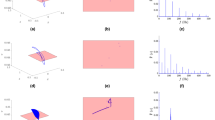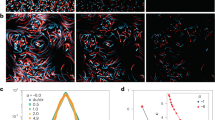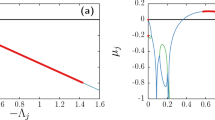Abstract
Order–disorder transitions are among the most important aspects of the problem of self-organization1. The Belousov–Zhabotinsky (B–Z) reaction is a convenient model for studying these transitions because it displays not only a variety of regular wave patterns but also chemical turbulence. Chaos in this reaction is usually thought to be a local property2, corresponding to a strange attractor in ordinary differential equations. In an active system, however, a different type of chaos (autowave chaos) may occur, which is not based on local mechanisms3,4. We have now found that this type of chaos develops from the interaction of propagating waves and stationary dissipative structures. This interaction initiates a chain reaction of spiral wave production resulting in a reduction of the characteristic scales of the wave pattern and in the occurrence of chaos. If the physical conditions are inappropriate for the formation of dissipative structures, then no chemical turbulence occurs and the wave pattern remains regular. Therefore, chaos appears in the reaction as a result of structure formation.
This is a preview of subscription content, access via your institution
Access options
Subscribe to this journal
Receive 51 print issues and online access
$199.00 per year
only $3.90 per issue
Buy this article
- Purchase on Springer Link
- Instant access to full article PDF
Prices may be subject to local taxes which are calculated during checkout
Similar content being viewed by others
References
Nicolis, G. & Prigogine, I. Self-Organization in Non-Equilibrium Systems (Wiley, New York, 1977).
Rössler, O. E. & Wegmann, K. Nature 271, 89–90 (1978).
Krinsky, V. I. Prob. Kibernet. 20, 59–80 (1968) (in Russian).
Ivanitsky, G. R., Krinsky, V. I., Zhabotinsky, A. M. & Zaikin, A. M. Sov. Sci. Rev. 2, 279–324 (1981).
Winfree, A. T. Science 175, 634–636 (1972).
Agladze, K. I. & Krinsky, V. I. Nature 296, 424–436 (1982).
Zaikin, A. N. & Zhabotinsky, A. M. Nature 225, 535–537 (1970).
Taranenko, A. M. thesis, Puschino Inst. of Biophys. (1977).
Zhabotinsky, A. M. & Zaikin, A. N. J. theor. Biol. 40, 45–61 (1973).
Kuramoto, Y. Progr. theor. Phys. 64, 346–367 (1978).
Showalter, K. J. chem. Phys. 73, 3735–3742 (1980).
Author information
Authors and Affiliations
Rights and permissions
About this article
Cite this article
Agladze, K., Krinsky, V. & Pertsov, A. Chaos in the non-stirred Belousov–Zhabotinsky reaction is induced by interaction of waves and stationary dissipative structures. Nature 308, 834–835 (1984). https://doi.org/10.1038/308834a0
Received:
Accepted:
Issue Date:
DOI: https://doi.org/10.1038/308834a0
This article is cited by
-
Influence of a circular obstacle on the dynamics of stable spiral waves with straining
Scientific Reports (2022)
-
Emergent Bioanalogous Properties of Blockchain-based Distributed Systems
Origins of Life and Evolution of Biospheres (2021)
-
Audible sound-controlled spatiotemporal patterns in out-of-equilibrium systems
Nature Chemistry (2020)
-
Chaotic behavior of the CML model with respect to the state and coupling parameters
Journal of Mathematical Chemistry (2019)
-
Transition from spirals to defect turbulence driven by a convective instability
Nature (1996)
Comments
By submitting a comment you agree to abide by our Terms and Community Guidelines. If you find something abusive or that does not comply with our terms or guidelines please flag it as inappropriate.



